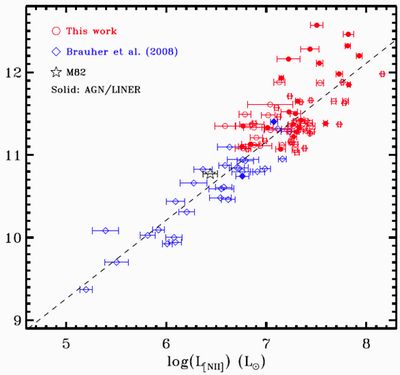A Herschel Survey of the [N II] 205 μm Line in Local Luminous Infrared Galaxies
2013-03-08The [N II] 205 205 μm emission is an important cooling line for the ionized interstellar medium, but scarcely studied due to technique limitations. Recently, PMO scientists, Dr. Yinghe Zhao and Yu Gao, and their worldwide collaborators, studied statistically, for the first time, the [N II] 205 μm line emission for a large sample of local luminous infrared galaxies using Herschel SPIRE FTS data. They found that L[N II] correlates almost linearly with LIR for non-active galactic nucleus galaxies (all having LIR < 1012 Lsolar) in their sample (see Fig 1), which implies that L[N II] can serve as a star formation rate tracer which is particularly useful for high-redshift galaxies that will be observed with forthcoming submm spectroscopic facilities such as ALMA. Their analysis also shows that the deviation from the mean L[N II]-LIR relation correlates with tracers of the ionization parameter, which suggests that the scatter in this relation is mainly due to the variations in the hardness, and/or ionization parameter, of the ambient galactic UV field among the sources in the sample.

By with ZHAO Yinghe
Fig 1: [N II] 205 μm plotted against total infrared luminosities for normal and luminous infrared galaxies. The circles (red) are galaxies having Herschel observations. The diamonds (blue) are galaxies from Brauher et al. (2008), for which an additional uncertainty of about 0.3 dex should be taken into account besides the plotted error bar. The superposed line represents a geometrical mean, least-squares linear fit to all data points except for those solid symbols.
This work was published in the ApJ Letters, please see Yinghe Zhao et al. 2013, ApJ, 765, L13 (http://adsabs.harvard.edu/abs/2013ApJ...765L..13Z) for more details.

 Search
Search

